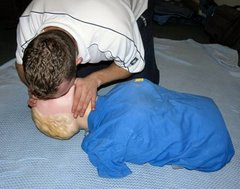Fractures
A fracture is a break or crack in a bone. It usually requires considerable force to fracture a bone unless it is old and diseased, or young and supple. Fractures fall into two broad categories:
Us first aid trainers have a useful mnemonic to help us remember the signs and symptoms of a fracture: PLUSDICT:
- 'Open fractures' where the bone is protruding through the skin. An open fracture is usually accompanied by significant blood loss - the main priorities in this case are to control the bleeding, keep the injured area still and prevent infection of the open wound.
- 'Closed fractures' where the damaged bone is contained within the skin. A closed fracture is contained within the skin and there is no external bleeding, although there is usually some internal bleeding caused by contusions (bruises) and tissue damage - the priority here is to keep the injured area still.
Us first aid trainers have a useful mnemonic to help us remember the signs and symptoms of a fracture: PLUSDICT:
- Pain
- Loss of power
- Unnatural movement
- Swelling or bruising
- Deformity
- Irregularity
- Crepitus (grinding sound of the bones)
- Tenderness
- Put on gloves, if available. Ask the casualty to keep still.
- Loosely cover the wound with a large, clean, non-fluffy pad or sterile dressing. Apply pressure to control the bleeding but DO NOT press on the protruding bone.
- Place clean padding over and around the dressing.
- Secure the dressing and padding with a bandage. Bandage firmly but not so tightly that it impairs circulation.
- Immobilise the injured area by supporting it with your hands or padding around it with clothing etc.
- Arrange for the casualty to get proper medical attention.
- Treat the casualty for shock if necessary - DO NOT raise a fractured leg. Monitor the casualty's level of response, breathing and pulse. Check circulation beyond the bandage every 10 minutes.
- DO NOT move the casualty until the injured area is supported unless they are in immediate danger. DO NOT press down on the protruding bone. DO NOT allow the casualty to eat, drink or smoke.
- Ask the casualty to keep still.
- Immobilise the injured area by supporting it with your hands or padding around it with clothing etc.
- Arrange for the casualty to get proper medical attention.
- Treat the casualty for shock if necessary - DO NOT raise a fractured leg. Monitor the casualty's level of response, breathing and pulse.
- DO NOT move the casualty until the injured area is supported unless they are in immediate danger. DO NOT allow the casualty to eat, drink or smoke.



